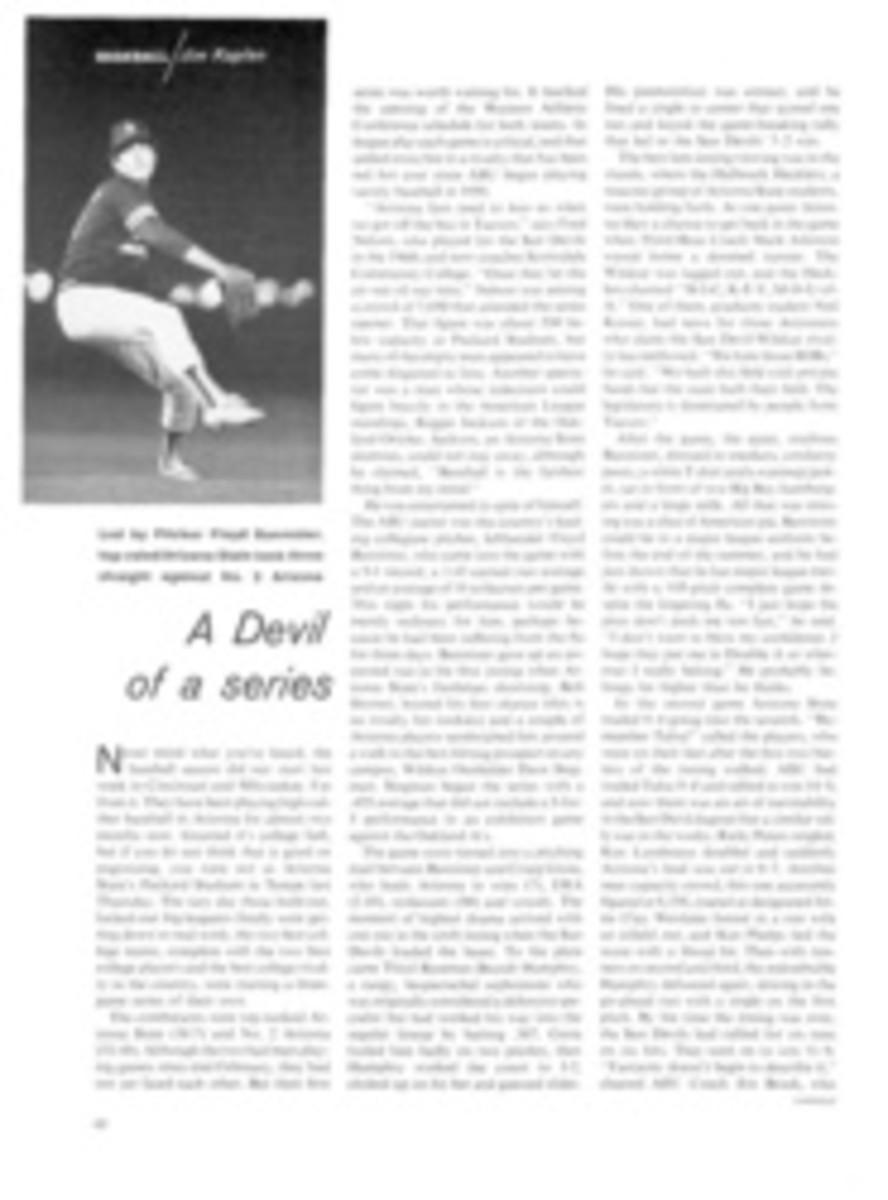
PRO QUARTERBACKS DON'T GET RATTLED, EVEN WHEN GASSING A DEN OF RATTLERS
In Abilene, Texas, diversion is where you are fortunate enough to find it, and Clint Longley used to amuse himself and his friends by carrying a trash basketful of live rattlesnakes into Abilene Christian dormitories. The Dallas Cowboy reserve quarterback says it was great sport to let a couple of angry rattlers loose in the halls. You should have been there, he says, the day he and several classmates located a prize den, capturing no less than 230 snakes.
The pastime of rattlesnake hunting is not all that unusual in those dry bed areas of the Southwest where western diamondbacks are as plentiful as rain and cool breezes are scarce. It began as a necessary chore, farmers and ranchers gathering each spring to do what they could to diminish the snake population. But in recent years virtually every town in West Texas hosts a Rattlesnake Roundup, complete with prizes and a pretty girl to reign over the festivities as Rattlesnake Queen.
Captured snakes are milked of venom for vaccine. Their hides are used for belts, billfolds, purses and hatbands, their skulls sold to curio-shop dealers and, finally, their meat fried. "A lot of people will tell you that it tastes like the white meat of chicken," says Longley. "Personally, I'll just stick with the chicken."
Longley spends each spring roaming the West Texas wastelands. "Finding snakes is easy once word gets around that you're looking for them," he says. "I've had ranchers call and tell me they've found a den in a back pasture and ask if I'd come out and get them."
It was such a call that had Longley and friends Wayne Smith, Terry Lankford and Louie Trammell driving down a dusty country road outside Abilene last spring. In the back of the pickup was their equipment—a covered trash basket, gasoline to be poured into the den (the fumes aggravate the snakes and drive them to the surface), strap sticks (broom handles with leather loops that can be drawn around the snakes), pinning sticks (which resemble golf putters and are used to hold down the snakes' heads) and a sack of crushed ice. This they hope they won't have to use. "If someone gets bit," Longley said, "we'll put ice on the area to slow the spread of the poison and get the hell to the hospital as fast as this ol' pickup will carry us."
By the time the hunters arrived at their destination the sun was high and the temperature was climbing fast. "There are all kinds of myths about rattlesnakes," Longley said. "For instance, most people think they thrive on hot weather but the truth is they can't tolerate being exposed to temperatures over 75° or 80° for any length of time. That's why in the summer you find them under rocks or in holes or under a pile of brush. They'll move around only in the early morning and late evening to find food.
"It's not too hot yet, though, so we should be able to find a few out of the den, sunning," he continued. "But in a couple of hours they'll be looking for shelter."
The den was located near an old, long abandoned line camp shack, a clapboard reminder of Texas cattlemen. A nearby cellar had caved in and its maze of crevices had become the home of rattlers. Three large males were curled atop large rocks near the den. Still lethargic from six months of hibernation, they took little notice as the hunters crept up on them and gently slipped the loops of the strap sticks around their necks. The snakes were dropped into the trash basket, and careful search began for other snakes outside the den. "That's the easy part," Longley said. "Those snakes weren't upset. You've just got to be sure you get all those that are out of the den before you start gassing the holes. When they start coming out of those rocks you don't have much time to worry about where you're standing or what you might step on."
The gassing of the den immediately provoked an angry hissing. "Get ready!" Wayne Smith yelled.
The snakes began appearing, their heads high, bobbing hypnotically, tongues darting. The hunters moved in before the snakes were completely out of the hole. As soon as one was bagged, another appeared. Snakes were escaping through the crevices.
It was over in a matter of minutes. A dozen diamondbacks, ranging in size from 2 to 4½ feet, had been captured. Despite continued gassing of the den, no more snakes appeared. Clearly, the hunters were disappointed. "It's getting a little late in the year," Longley said. "A lot of snakes have gone their separate ways for the summer. In the cold months the rattlesnake is a social creature, hibernating with others, but in the warm months he hunts and lives alone."
On the ride home Longley said not one of his Cowboy teammates had accepted his invitation to go on a rattlesnake hunt. He can't understand that, nor the discomfort of those who visit his Dallas townhouse and find a live rattlesnake in a living room terrarium.
"Everyone worries about getting bit," he said. "Shoot, I've never been bitten. It would be embarrassing to get bit." Turning the radio dial to a country music station, he steered the pickup off the dirt road and back onto the highway to Abilene. In the back, the crushed ice had all but melted away.

